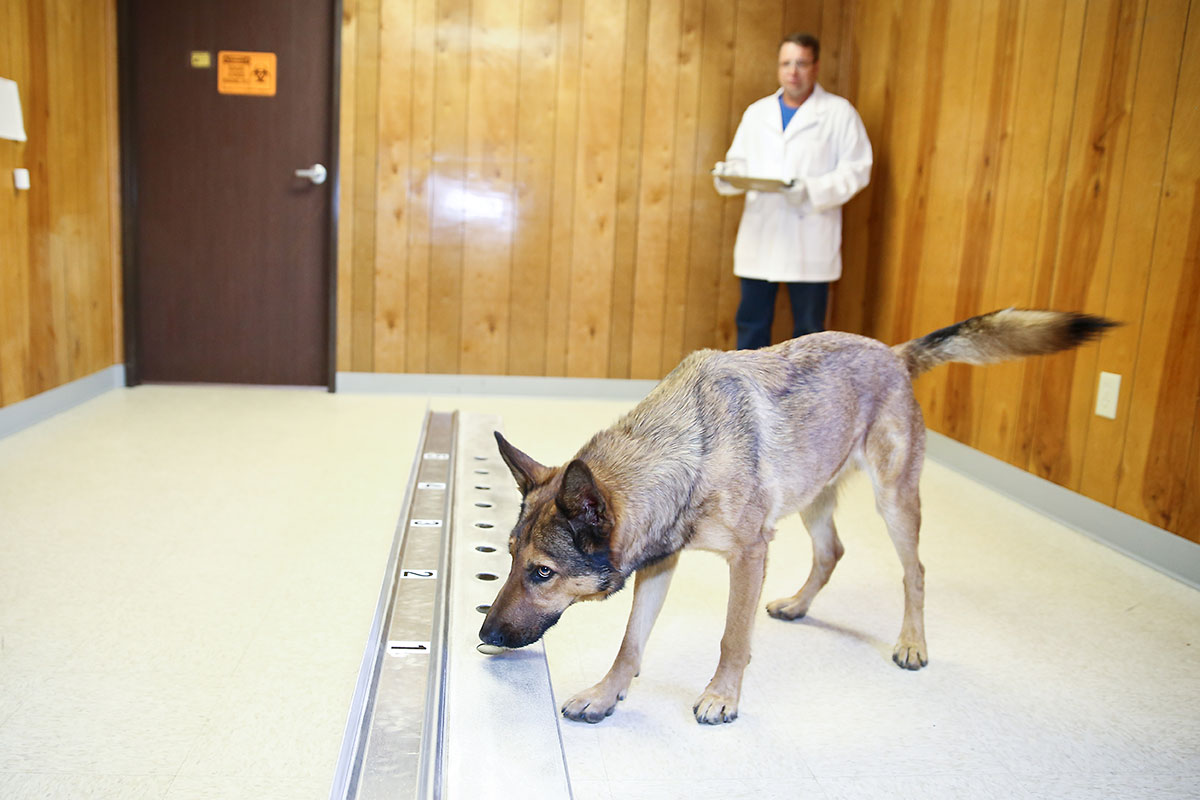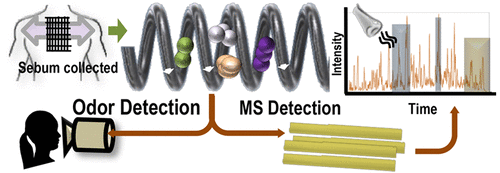Most of us have told someone, “You smell sick.” Infection and metabolic diseases are often associated with a pronounced change in how a person smells. Researchers are now discovering that many disease states alter metabolism, either overall or of specific tissues. These metabolic changes lead to changes in volatile molecules, which are gaseous compounds that can be either smelled or detected with special laboratory equipment or even dogs (Figure 1).

Figure 1. Training dogs to detect cancer by smell. Read more
The set of volatile organic compounds that are associated with an organism is called the “volatilome.” Changes in the volatilome can affect the odors associated with various parts of a person’s body. We can smell changes that affect a person’s breath, sweat, urine, or feces. Some dogs can sniff out cancer, likely by detecting the changes in metabolism of the cancer cells that cause changes in molecules that the dogs can smell. Some dogs can detect when a person is about to have a seizure. Could this also relate to changes in brain metabolism that lead to a detectable (to the dog at least) change in how the person smells?
A study by Trivedi and colleagues published in March 2019 reports the identification of a smell associated with Parkinson’s disease. The study was sparked by a person who was a “Super Smeller.” Her husband developed Parkinson’s disease and she found that she could detect a scent on her husband and other patients with the disease. The scent was strongest in the upper back and forehead, which are areas where glands in the skin produced a fluid called sebum. Sebum is a waxy, oily body fluid. Trivedi and colleagues collected sebum from patients with Parkinson’s disease and healthy control subjects. These samples were analyzed using a process called thermal desorption-gas chromatography-mass spectrometry (TD-GC-MS) (Figure 2).

Figure 2. The approach for detecting the molecules responsible for the unique smell of Parkinson’s disease patients. Read more
After collecting the data, the researchers used a computational approach to identify 17 volatile molecules that were significantly associated with the Parkinson’s disease patient samples and not the control samples. The Super Smeller reported that the odor was strongest in the presence of the molecules that increased in abundance in the Parkinson’s disease patients. Ultimately, the Super Smeller identified a mixture of 9 molecules as having a smell most similar to that of Parkinson’s disease patients.
The patients included some who had received drug treatment and some who had not. Both groups had similar volatile molecules in the sebum samples. Thus, drug metabolism or changes in metabolism resulting from drug treatment were not responsible for the differences between Parkinson’s disease patients and healthy subjects.
Abnormally high production of sebum, which can lead to seborrheic dermatitis, is an early symptom of Parkinson’s disease and often occurs before movement problems appear. Three of the molecules that were increased were perillic aldehyde, octadecanal, and eicosane. These compounds are associated with specific microbes and the change in their abundance may indicate that changes in the skin microbiota of Parkinson’s patients contributes to the specific odor.
This study shows that Parkinson’s disease is associated with a change in the composition of the volatile compounds in specific regions of the skin. A key question that remains unanswered is whether other causes of seborrheic dermatitis result in a similar increase in volatile compounds, which could make it difficult to determine if the person is developing Parkinson’s disease or has a different condition. Detailed information about the change in the volatilome could be used to develop a screen for Parkinson’s disease, either using TD-GC-MS, other laboratory methods, or even trained canine disease detectors, like the ones trained to detect cancer.
Highlighted Article
D. K. Trivedi, E. Sinclair, Y. Xu, D. Sarkar, C. Walton-Doyle, C. Liscio, P. Banks, J. Milne, M. Silverdale, T. Kunath, R. Goodacre, P. Barran, Discovery of Volatile Biomarkers of Parkinson’s Disease from Sebum. ACS Central Science 5, 599-606 (2019). DOI: 10.1021/acscentsci.8b00879 PubMed
Cover image details
Cite as: N. R. Gough, The Scent of Parkinson’s Disease. BioSerendipity (16 Mary 2019) https://www.bioserendipity.com/the-scent-of-parkinsons-disease/

